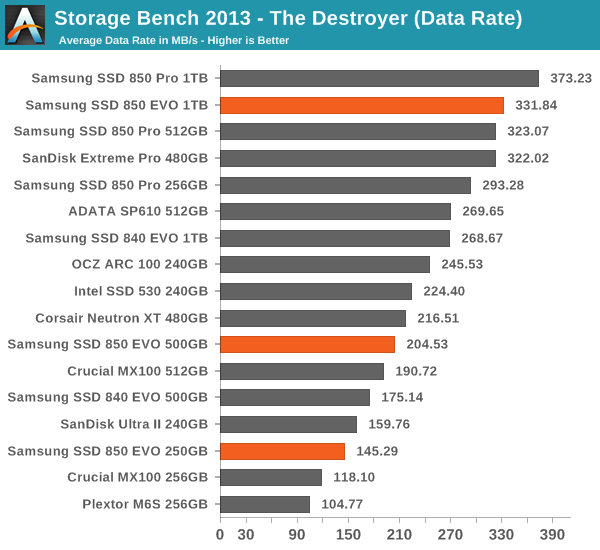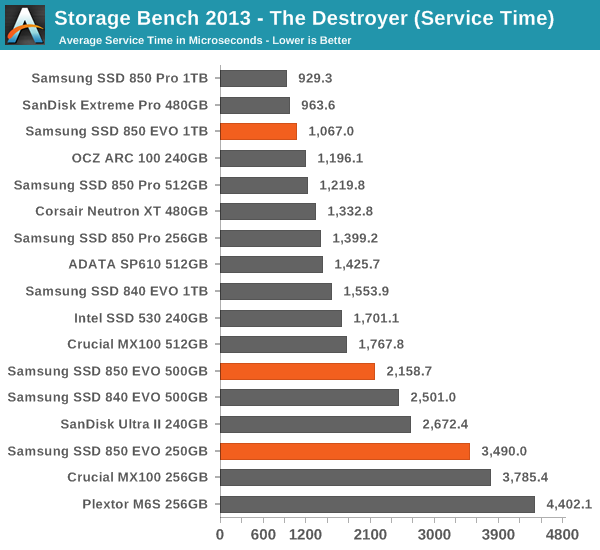Samsung SSD 850 EVO (120GB, 250GB, 500GB & 1TB) Review
by Kristian Vättö on December 8, 2014 10:00 AM ESTAnandTech Storage Bench 2013
Our Storage Bench 2013 focuses on worst-case multitasking and IO consistency. Similar to our earlier Storage Benches, the test is still application trace based – we record all IO requests made to a test system and play them back on the drive we are testing and run statistical analysis on the drive's responses. There are 49.8 million IO operations in total with 1583.0GB of reads and 875.6GB of writes. I'm not including the full description of the test for better readability, so make sure to read our Storage Bench 2013 introduction for the full details.
| AnandTech Storage Bench 2013 - The Destroyer | ||
| Workload | Description | Applications Used |
| Photo Sync/Editing | Import images, edit, export | Adobe Photoshop CS6, Adobe Lightroom 4, Dropbox |
| Gaming | Download/install games, play games | Steam, Deus Ex, Skyrim, Starcraft 2, BioShock Infinite |
| Virtualization | Run/manage VM, use general apps inside VM | VirtualBox |
| General Productivity | Browse the web, manage local email, copy files, encrypt/decrypt files, backup system, download content, virus/malware scan | Chrome, IE10, Outlook, Windows 8, AxCrypt, uTorrent, AdAware |
| Video Playback | Copy and watch movies | Windows 8 |
| Application Development | Compile projects, check out code, download code samples | Visual Studio 2012 |
We are reporting two primary metrics with the Destroyer: average data rate in MB/s and average service time in microseconds. The former gives you an idea of the throughput of the drive during the time that it was running the test workload. This can be a very good indication of overall performance. What average data rate doesn't do a good job of is taking into account response time of very bursty (read: high queue depth) IO. By reporting average service time we heavily weigh latency for queued IOs. You'll note that this is a metric we have been reporting in our enterprise benchmarks for a while now. With the client tests maturing, the time was right for a little convergence.

The faster NAND and better IO consistency results in increased performance in our 2013 Storage Bench. The 1TB version shines in the test and isn't far from the 850 Pro, but the 500GB and 250GB models end up being middle-class performers. Especially the performance of the 250GB model is a bit underwhelming because it is beaten by the Ultra II, even though the 850 EVO should have a performance advantage thanks to V-NAND.











97 Comments
View All Comments
eanazag - Monday, December 8, 2014 - link
Turbowrite is a default feature. It is marketing speak for optimizations to increase write performance in write workloads. It can't be turned on or off.erple2 - Wednesday, December 10, 2014 - link
Well, it has to be able to be turned on/off, as Kristian has a chart showing the difference in write speeds with it on/off. However, unlike "RAPID", there is no downside to leaving it on.geniekid - Monday, December 8, 2014 - link
Well written conclusion.andrewbaggins - Monday, December 8, 2014 - link
It's hard to understand why your SSD reviews fail to include Idle Power Consumption charts. For the hundreds of millions of PCs and laptops in use which do not support the so-called Slumber Power it would be far more useful if you included a chart for typical or average power consumed during Idle state.metayoshi - Monday, December 8, 2014 - link
"Hundreds of millions of PCs and laptops in use which do not support the so-called Slumber Power."Woah... I don't know where you got that "hundreds of millions" number from, but any system that supports SATA is able to support Slumber. Slumber has been in the SATA spec since forever, and pretty much all 2.5" drives, and some 3.5" drives support this power state.
metayoshi - Monday, December 8, 2014 - link
P.S. As an example, I have a Core 2 Quad Q6600 sitting in my cubicle at work on an Asus PSE WS Pro motherboard. I have no Idea how old this thing is, but it's running a SATA-II 3.0 Gbps interface, and that great grandfather of a system supports HIPM+DIPM, and does Partial and Slumber on a variety of SSDs and HDDs.eanazag - Monday, December 8, 2014 - link
Newegg has a promotion for these drives ending 12/14/14 (US $) -120GB @ $89.99
250GB @ $139.99
500GB @ $249.99
1TB @ $469.99
eddieobscurant - Monday, December 8, 2014 - link
I think an 120gb 850 evo usb thumb drive would be awesome .dwade123 - Monday, December 8, 2014 - link
Realworld: all modern ssds have similar windows boot and game loading time. All these synthetic tests are just for reviewers to have something talk about, and marketing purposes. Meh.StrangerGuy - Monday, December 8, 2014 - link
I would rather want a SSD that has 90% of a MX100 but only 50% dollar per GB, instead of extra performance that 99% of SSD buyers will not never benefit for more money.